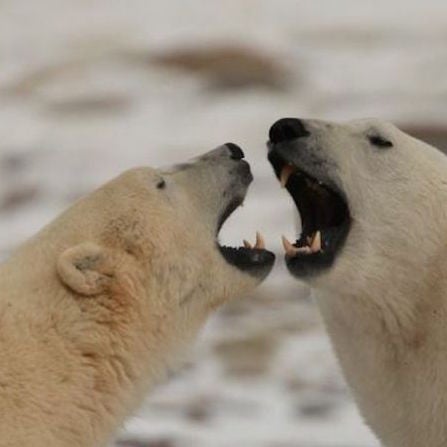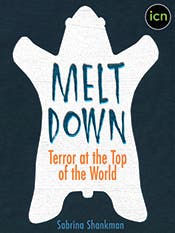Q&A: Polar Bears on the Brink


On July 24, 2013, seven American hikers encountered a polar bear in Canada’s Torngat Mountains, a harrowing encounter that left one member of the group—48-year-old Matt Dyer—clinging to life. The group’s survival story is at the heart of Meltdown: Terror at the Top of the World, a new e-book published by InsideClimate News in association with VICE Media.
The riveting story also raises broader scientific questions about the nature of human/bear encounters in the age of climate change. BACKPACKER caught up with author and reporter Sabrina Shankman about the uptick in polar bear attacks, the loss of sea ice, and the future of the species.
BACKPACKER: Talk a bit about the genesis of this story. How did you come to know the people involved?
SABRINA SHANKMAN: I started at InsideClimate News in September [2013], and shortly after I came on board, our publisher came to me and said, ‘I’ve got a story I’d like you to check out.’ One of his friends [who would later join ICN’s advisory board], Larry Rodman, had just told him about this crazy trip that he’d been on in the Arctic with the Sierra Club where a guy had been attacked by a polar bear. So I started looking into it and very quickly landed on a lot of science that showed that as climate change increases, there’s expected to be an increase in encounters between humans and polar bears, because the bears are losing their habitat.
So that was a flag for us that maybe this wasn’t just a quick post for the website, that it was something that warranted looking into further. I don’t think anyone knew that it would turn into a yearlong project, a partnership with VICE, and that there would be a documentary as well.
BP: What was the first step in your reporting?
SS: The first step was reaching out to the members of the Sierra Club group. We had Larry as an entry point, but we wanted to get everyone because it’s such a visceral story that I wanted to be able to tell it from the perspective of all seven members of the trip. These are private people who certainly aren’t looking for publicity. They experienced something incredibly traumatic just a couple months earlier. So I reached out not knowing how that would go. And initially, a couple folks were reluctant, but they have a strong relationship with each other and the more they talked about it among themselves, the more comfortable they became. They also became more comfortable with the idea of InsideClimate News, the idea that we would not be sensationalizing their story.
BP: Describe the region where this incident took place for those who’ve never been up to the northern reaches of Canada.
SS: Torngat Mountains National Park is actually one of the newer national parks in Canada, and it’s at the very northeastern tip of Labrador. It’s this incredible range where the mountains come right down into the water. I’ve never seen anything like it. It’s incredibly remote, there’s gorgeous wildlife—it felt prehistoric. It was amazing to realize just how far away from your own world you can get. And we weren’t even that high up! There’s still a lot further you can go.
BP: What’s known about the history of run-ins between polar bears and humans? Did you discover any trends?
SS: There’s an international effort right now to get a better sense of this data, because there hasn’t been great reporting, especially within specific Arctic countries. There was a biologist named James Wilder with the U.S. Fish and Wildlife Service—he’s since changed jobs—but when I interviewed him, he was working to compile the first-ever database. And it’s a job, because we don’t really know anything out of Russia, and Russia has a lot of bears. But what he found is that there has definitely been an increase in interactions between humans and polar bears. Back in the 1960s and ‘70s, you were looking at fewer than 10 attacks per decade. The decade we’re currently in is on pace for 35 attacks. When you talk to people who work in the field, they say it without batting an eye.
At the end of the day, it’s also important to remember that we’re not talking about huge numbers here. And you also can’t attribute climate change to any specific attack. We don’t know why this bear attacked Matt Dyer in the Torngat Mountains last year, so it’s important to make that distinction.
BP: A town near Churchill cancelled Halloween this year for fear of bears, and a study released the other day showed a 40% polar bear population drop in the Beaufort Sea over the course of a decade. These are just data points, but does it seem like they’re all related somehow?
SS: Yep, it is interesting, and it’s all part of the equation.
BP: How did you balance the narrative of this harrowing survival story with scientific background on topics like sea ice loss?
SS: The actual facts of what happened on this trip did me a lot of favors as a reporter interested in the science because going in, I didn’t know much about sea ice loss in that eco-region or much about the specific polar bear population there. What I learned is that that specific area has seen 50 fewer days of sea ice coverage since the 1970s, so right now, you’re looking at a significant decrease in the number of days that polar bears can be out on the ice.
And at the same time, other research is showing early indications that the bear population might be in trouble because their body condition is in decline. The cub survival rate is going way down. And those tend to be the things that happen right before populations decline. So the fact that that’s happening to this specific group of bears gave me an opening to really unpack that science. The scientists who did that work were very patient and willing to spend a lot of time with me on the phone so that I could explain it to a general audience in a way that makes sense.
BP: Was there anything particular surprising that you found?
SS: I learned that in 2009, there had been a run-in with a starving bear not far from where the [Dyer] attack happened. And there were these photos—they were some of the most shocking images I’ve ever seen of a polar bear. I sent them to some of the biologists to confirm that it was a sick-looking bear and there were audible gasps on the phone as they opened the email. And then, after my trip up to the Torngats, the fishing boat we were sleeping on, the captain told me that there was a guy who’d come up there for years telling stories about being dragged out of a tent by polar bears.
So based on public knowledge of polar bear attacks in the Torngats, Matt Dyer’s was the only one. But in short order, I found out about four more.
BP: That speaks to the idea that the data we have on polar bear encounters is really incomplete.
SS: Exactly. The stuff that was the most eye-opening to me is the science right now that shows that fewer days out on the sea ice has a direct effect on female polar bears’ ability to reproduce or have their cubs survive. It’s not just polar bears. When you look at how earlier melting of the sea ice has drastic effects on the entire Arctic ecosystem all the way up the food chain. When you start to mess with that timing, there’s ripples throughout that have serious consequences.
BP: Have we gone too far down the road of sea ice loss now? Or were the biologists you spoke with optimistic about the future of the polar bear population?
SS: The biologists think that we can still help, but were split on whether there’s time to make a significant difference. For instance, Steven Amstrup, the chief scientist for Polar Bears International, says that there is still time and that we need to look at greenhouse gases now and that there are changes by policy makers and changes by individuals that can make a difference for the bears and for ourselves. That’s the message he’s putting out there.
On the flip side, one the biologists who was incredibly patient with me is a guy named Andrew Derocher, and while he would love that to be the case, his takeaway is that the future of polar bears is essentially written. That at this point, what’s been set in motion with climate change and sea ice loss is going to result in a situation where the southern bear populations—in the Torngats, in the Beaufort Sea, in Hudson Bay—will just be gone. A smaller population might still exist right at the top of the earth where sea ice will stick around a bit longer, but that ultimately, they’re doomed. Not a happy takeaway.
BP: Will we start seeing more “pizzly bears,” a.k.a. polar bear / grizzly hybrids then?
SS: Polar/grizzly bear hybrids are happening now. We don’t know how many, it’s a small number. But it’s not a hypothetical, and we know that they can mate and have fertile offspring. The thing is, even if they start mating and the polar bear genes live on that way, it’s still a different species. What makes a polar bear so fascinating, in my mind, is the way that it’s specifically evolved to live in its habitat. That’s what’ll be lost, theoretically.
I will say, they are the most amazing animals I’ve ever seen in the wild. We saw a bunch of polar bears when we were up in the Torngats and nothing could have prepared me. We saw one bear running along the shore and just to see a huge animal like that, running so fast and also just how nimble it was…We watched one bear run up over a ridge and we hiked around, keeping our distance. Then it just plunged down into this area where there was a pond, and just hung out in the water for the longest time and you could just tell it was overheated…They are incredible animals.
Sabrina Shankman is a producer and reporter at InsideClimate News. She worked previously on documentaries for the PBS show “Frontline” and has written for ProPublica, The Wall Street Journal, and the Associated Press.
This interview has been lightly edited and condensed.